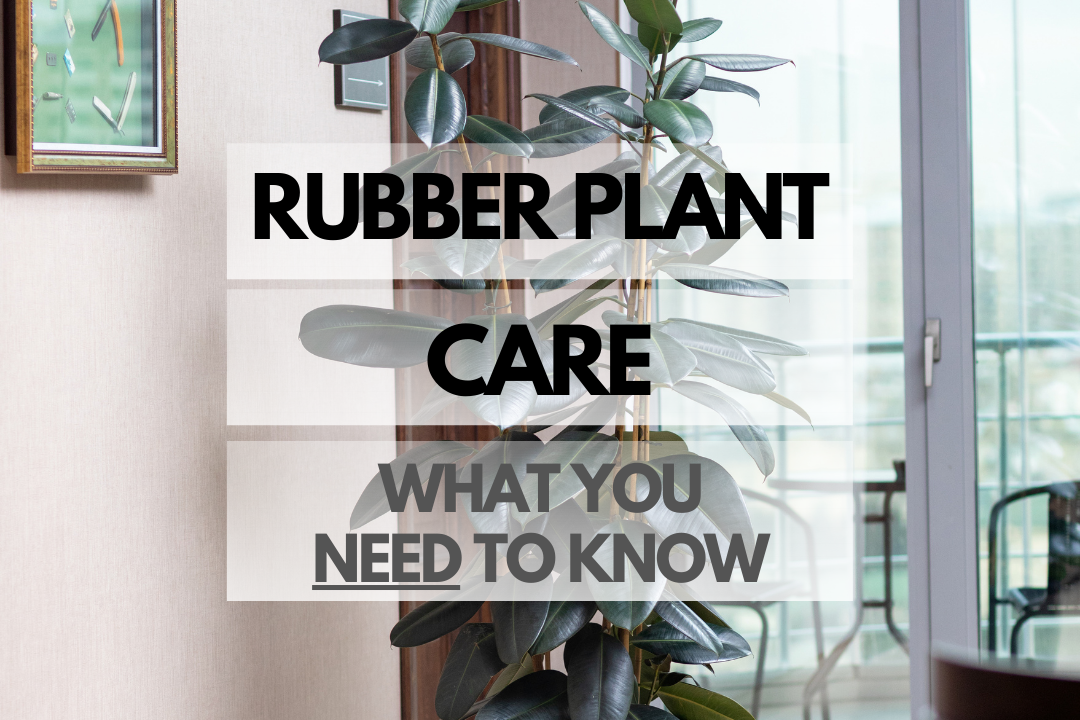Are you planning to add a rubber plant to your indoor garden? Perfect choice! These versatile plants are not only beautiful but also easy to care for. In this guide, we’ll cover all you need to know about rubber plant care, including sunlight, soil, watering, pruning, temperature, and common problems. So, let’s get started!
Rubber Plant Care Guide
Quick Reference Table: Caring for Rubber Plant
| Aspect | Details |
|---|---|
| Sunlight | Bright, indirect light |
| Soil | Well-draining, loamy mix |
| Watering | Allow soil to dry between waterings |
| Pruning | Remove damaged leaves and trim to desired shape |
| Temperature | 60-75°F (15-24°C) |
Rubber Plant Sunlight: Do They Need It and How Much?
Rubber plants love bright, indirect sunlight. Placing your plant near a window with filtered light will make them happy. Avoid exposing them to direct sunlight, as it can scorch their leaves. If you notice that the leaves are getting leggy or discolored, it might be a sign that the plant needs more light.
Rubber Plant Soil Tips
A well-draining, loamy soil mix is ideal for rubber plants. You can use a mixture of peat, bark, and perlite or vermiculite. Ensure that the pot has drainage holes to prevent waterlogging, which can lead to root rot.
Rubber Plant Watering and Frequency
Rubber plants prefer to have their soil dry out between waterings. Overwatering can lead to root rot, so it’s best to wait until the top inch of soil is dry before watering again. Depending on the size of the pot and the humidity in your home, this might be once a week or once every two weeks. Always use a well-draining pot to ensure excess water can escape.
Pruning Rubber Plant Properly
Regular pruning helps your rubber plant maintain a neat appearance and encourages bushier growth. Remove damaged or yellowing leaves, and trim the plant to your desired shape. Prune in spring or summer when the plant is actively growing for the best results.
Optimal Rubber Plant Temperature: Can They Tolerate the Cold?
Rubber plants prefer temperatures between 60-75°F (15-24°C). They can tolerate temperatures as low as 50°F (10°C) for short periods, but prolonged exposure to cold temperatures can cause damage. Make sure to keep your plant away from drafty windows and doors during the colder months.
Common Rubber Plant Problems
Yellowing Leaves
Yellowing leaves can be a sign of overwatering or lack of nutrients. Make sure you’re allowing the soil to dry between waterings and consider adding a slow-release fertilizer to the soil.
Leaf Drop
Leaf drop can be due to sudden changes in temperature, overwatering, or underwatering. Ensure your plant is in a stable environment and adjust your watering schedule accordingly.
Pests
Rubber plants can be susceptible to pests like spider mites, mealybugs, and scale. Keep an eye out for these pesky critters and treat them with insecticidal soap or neem oil when needed.
Rubber Plant Outdoors vs Indoors
Rubber plants can grow both indoors and outdoors, depending on your climate. Here are some pros and cons to consider:
| Location | Pros | Cons |
|---|---|---|
| Indoors | Easy to control temperature and humidity; suitable for most climates | May require supplemental lighting; limited space for growth |
| Outdoors | Larger growth potential; natural lightingRequires warmer climate; more vulnerable to pests and weather fluctuations |
Best Pots for Rubber Plant
When choosing a pot for your rubber plant, look for one with drainage holes to prevent waterlogging. A well-draining pot will help keep the roots healthy and prevent root rot. You can opt for a terracotta, ceramic, or plastic pot, depending on your personal preference and home decor style. Make sure to select a pot that is slightly larger than the root ball to allow for growth, and repot your rubber plant every couple of years as it grows.
Rubber Plant Facts
Rubber Plant Benefits
- Air purifier: Rubber plants are known to remove toxins from the air, helping to improve indoor air quality.
- Attractive foliage: Their large, glossy leaves add a touch of elegance to any space.
- Low maintenance: Rubber plants are easy to care for, making them a great choice for beginners and busy plant owners alike.
- Adaptable: They can thrive in a variety of indoor conditions, including low light and fluctuating temperatures.
Growth Rates: How Fast Do They Grow?
Rubber plants have a moderate growth rate, typically growing about 12-24 inches (30-60 cm) per year when provided with proper care. With ideal conditions, they can reach heights of up to 10 feet (3 meters) indoors.
Rubber Plant Lifespan
With proper care, rubber plants can live for many years, often 15 years or more. Ensuring the right balance of light, water, temperature, and nutrition will help your rubber plant thrive and live a long life.
Are Rubber Plants Safe?
Rubber plants have a mild toxicity due to the sap they produce. Ingesting the sap can cause irritation in the mouth and throat, but the risk is generally low. It’s best to keep rubber plants out of reach of pets and children to avoid any potential issues.
Rubber Plant Flowers
While rubber plants rarely flower indoors, they can produce small, non-showy flowers when grown outdoors in their natural habitat. These flowers are typically greenish-white and occur in clusters.
Rubber Plant Types and Varieties
Ficus elastica ‘Decora’
This popular variety features large, dark green leaves with a glossy finish. It’s known for its robust growth and is a common choice for indoor gardeners.
Ficus elastica ‘Variegata’
Also known as the Variegated Rubber Plant, this variety has stunning green leaves with creamy white edges. It adds a pop of color to any space and is a favorite among plant enthusiasts.
Ficus elastica ‘Robusta’
This variety is similar to ‘Decora’ but has wider and more rounded leaves. It’s a sturdy and vigorous grower that makes an excellent focal point in any room.
Ficus elastica ‘Tineke’
‘Tineke’ is a beautiful variegated variety with green leaves that have light cream and pink markings. This eye-catching plant is a great addition to any indoor garden.
Rubber Plant Pros and Cons
| Pros | Cons |
|---|---|
| Low maintenance | Mildly toxic to pets and children |
| Attractive foliage | Requires pruning to maintain shape |
| Air purifying | Can grow quite large, requiring adequate space |
| Adaptable to various conditions | Rarely flowers indoors |
Rubber Plant Cost
The cost of a rubber plant can vary depending on the size and variety. Smaller plants can be found for around $10-$20, while larger, more mature plants can cost $50 or more. Variegated varieties may also be more expensive due to their unique appearance.
Where to Buy Rubber Plants
Rubber plants can be found at local nurseries, garden centers, and even some big-box stores. Online retailers also offer a wide selection of rubber plants, with options to suit any budget and preference.
Is Rubber Plant Propagation in Water Possible?
Yes! Rubber plant propagation in water is possible and relatively easy. Simply take a stem cutting with a few leaves, remove the lower leaves, and place the cutting in a container of water. Change the water every few days and wait for roots to form. Once a healthy root system has developed, transfer the cutting to a pot with well-draining soil.
Additional Resources
- Royal Horticultural Society – Rubber Plant Care
- Garden.org – Rubber Plant Forum
- Facebook Group – Indoor Plant Lovers
FAQ for Rubber Plant Care
Are Rubber Plants toxic to cats?
Yes, rubber plants are mildly toxic to cats. The sap can cause irritation in the mouth and throat if ingested. Keep the plant out of reach of your feline friends.
Are Rubber Plants toxic to dogs?
Yes, rubber plants are mildly toxic to dogs as well. Keep the plant out of reach to avoid any potential issues.
Are Rubber Plants toxic to kids?
While not highly toxic, rubber plants can cause irritation in the mouth and throat if ingested by children. It’s best to keep the plant out of reach.
How tall do Rubber Plants get?
Indoors, rubber plants can grow up to 10 feet (3 meters) tall with proper care. They can be pruned to maintain a desired height and shape.
Can Rubber Plants live outside?
Rubber plants can be grown outside in warm climates where temperatures don’t dip below 50°F (10°C). However, they are primarily grown as indoor plants in most regions.
Are Rubber Plants poisonous?
Rubber plants are mildly poisonous due to the sap they produce. Ingesting the sap can cause irritation in the mouth and throat. Keep the plant out of reach of pets and children.
How often should I water my Rubber Plant?
Water your rubber plant when the top 1-2 inches (2.5-5 cm) of soil feel dry to the touch. Overwatering can lead to root rot, so be sure to allow the soil to dry out between waterings.
In conclusion, rubber plants are beautiful, low-maintenance, and air-purifying additions to any indoor space. With proper care and attention, they can thrive for many years. Whether you’re new to plant care or a seasoned green thumb, rubber plants are a rewarding choice for any plant enthusiast.

